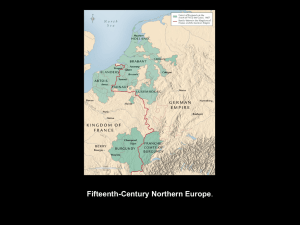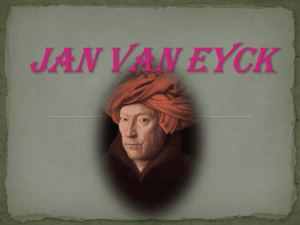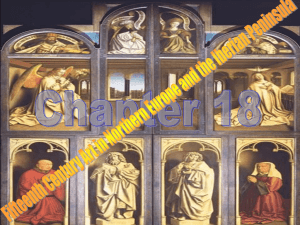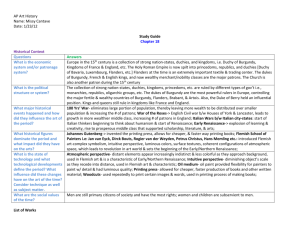Northern Renaissance Painting
advertisement
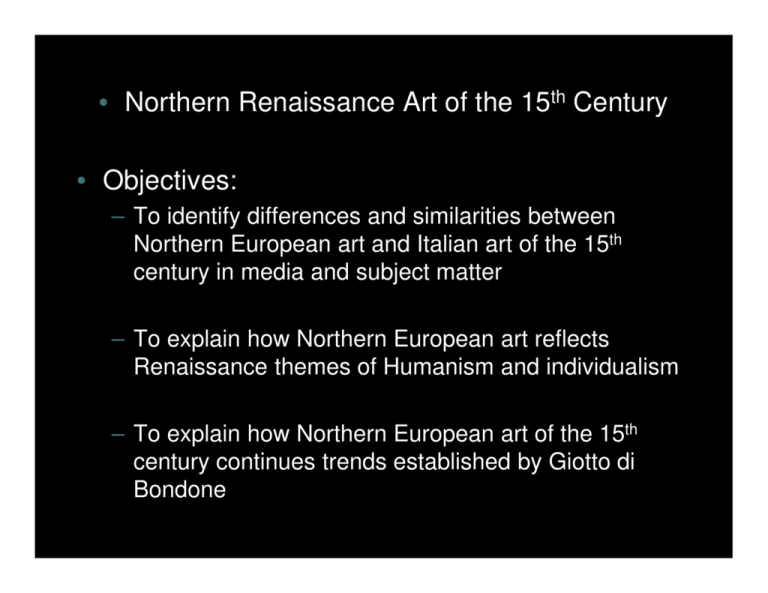
• Northern Renaissance Art of the 15th Century • Objectives: – To identify differences and similarities between Northern European art and Italian art of the 15th century in media and subject matter – To explain how Northern European art reflects Renaissance themes of Humanism and individualism – To explain how Northern European art of the 15th century continues trends established by Giotto di Bondone Northern Art in the Fifteenth Century • Interest in natural world with close observation and detailed recording of nature • More emphasis on Portraiture and scenes of daily Life but religious painting still important • Development of Oil Paining, Woodcuts, and Engravings • Important Artists – – – – Jan van Eyck Claus Sluter Rogier van der Weyden Limbourg brothers Fifteenth-Century Northern Europe. Pierre Robin (?). Church of Saint-Maclou, Rouen. 1432–1521; façade c. 1500–1514. Diptych, Triptych (Line Drawings). Altar and Polyptych Altarpiece (Line Drawing). • Claus Sluter 1360-1406 • Straight out of Haarlem (Holland) • Employed by the Duke of Burgundy (Philip the Bold) • Worked on the Chartreuse at Champmol, Burgundy as an apprentice to another Flemish sculptor (Jean de Marville) • Eclipses his master with his work, “The Well of Moses” Claus Sluter. Well of Moses, detail of Moses and David. 1395–1406. Height of figures about 5’ 8”. Limestone Charteuse de Champmol, Dijon, France • Well of Moses • An unfinished work for the main cloister at Champmol. A figure of Christ on the cross surrounded By, Mary, Mary Magdalen and John stood upon a limestone pedestal on which six old testament figures including Moses and David are carved. Sluter changed from idealized facial features, elongated forms and vertical drapery in favor of personalized faces and horizontal folds which emphasize body mass. The figures were originally painted: Moses wore a gold mantel with a blue lining over a red tunic. Giovanni Boccaccio. Page with Thamyris. 1402. 14 × 9 1/2”. • Paul, Herman and Jean Limbourg • Dutch Painters • In 1404 employed by the Duke of Berry, who was an avid book collector • Created a book of hours – Prayer/devotional book – Calendar of holy days Paul, Herman, and Jean Limbourg. February, Life in the Country. Très Riches Heures. 1411–1416. 11 3/8 × 8 1/4”. Colors & Ink on Parchment. Paul, Herman, and Jean Limbourg. January, the Duke of Berry at Table. Très Riches Heures. 1411–1416. 11 3/8 × 8 1/4”. Colors & ink on Parchment Mary of Burgundy Painter. Mary at Her Devotions, Hours of Mary of Burgundy. Before 1482. Size of image 7 1/2 × 5 1/4”. Colors & Ink on Parchment • Mary at Her Devotions • The painting contains two scenes one within the other. • In the outer scene, Mary, daughter of the Duke of Burgundy is surrounded by devotional aids: her book, prayer beads and flowers (carnations symbolizing nails of the cross and irises symbolizing Mary’s sorrow) Her lap dog also symbolizes fidelity. As a result of her devotion she is transported into the inner scene in which she becomes an attendant of of the Virgin Mary. Workshop of the Master of Flémalle. Mérode Altarpiece (Triptych of the Annunciation) (Open). c. 1425–1430s. Center 25 1/4 × 24 7/8”; each wing approx. 25 3/8 × 10 3/4” Oil on Wood Panel. Located at the Metropolitan (cloisters collection) • Merode Altarpiece • Triptych in which a religious scene has been placed in contemporary life. Central scene is an Annunciation in which Mary is reading the Bible and dressed in Renaissance clothing in a Flemish house. To the left, the donors watch the scene through the doorway; to the right Joseph works in a shop which overlooks a Flemish city. In the annunciation scene, the lilies symbolize Mary’s purity, the kettle hints at her function as a vessel and the hanging “towel” is considered to be a Jewish prayer shawl. A small figure of Christ bearing the cross heads in on a beam of light, which is centered on Mary. Workshop of the Master of Flémalle. A Flemish City (Detail of Right Wing of the Merode Altarpiece). • Jan Van Eyck • Active from 1420’s-1441 • Court painter for Duke of Burgundy (Philip the Good, uncle to king of France) • Served as a courtier and diplomat to Portugal • Mistakenly credited with inventing oil painting • Personal Motto “as I can, not as I would” • “No other painter equal to his taste or so excellent in art and science.” • Trained as a miniaturist Jan van Eyck. Man in a Red Turban. 1433. 13 1/8 × 10 1/4”. Oil on Wood. Located at the National gallery in London Jan van Eyck. Double Portrait of a Giovanni Arnolfini and His Wife. 1434. 33 × 22 1/2”. Oil on Wood Panel. Located at national Galley in London • Portrait of Giovanni Arnolfini • Considered to be a real portrait (not idealized). The scene shows the wealth and status of the individual through his silk & velvet heuque (sleeveless robe), the oriental rug, oranges in the background and lavish bed (which may also imply fertility). Prayer beads and a figure of St. Margaret (protector of women in childbirth) display their piety. The Mirror may also indicate the allseeing eye of God. Jan van Eyck. Detail of Mirror and Signature in a Double Portrait of a Giovanni Arnolfini and His Wife. 1434. Jan and Hubert (?) van Eyck. Ghent Altarpiece (Open), Adoration of the Mystic Lamb. Completed 1432. 11’ 5 3/4" × 15’ 1 1/2”.Oil on Wood . Located at the cathedral of St Bavo, Ghent Rogier van der Weyden. Deposition. Before 1443, possibly c. 1435–1438. 7’ 2 5/8" × 8’ 7 1/8”. Oil on Wood Panel. Located at the Museo del Prado, Madrid Petrus Christus. A Goldsmith in His Shop. 1449. 38 5/8 × 33 1/2”.Oil on Wood Panel. Located at Metropolitan Museum, New York Hans Memling. Diptych of Maarten Van Nieuwenhove. 1487. Each panel (including frames) 20 1/2 × 16 1/4”. Oil on Wood Woodcuts and Engravings on Metal. Martin Schongauer. Demons Tormenting St. Anthony. c. 1480–1490. 12 1/4 × 9”. Engraving. Located at the Metropolitan Museum of Art Michael Wolgemut, Wilhelm Pleydenwurff and workshop. The City of Nuremberg. Nuremberg Chronicle, published by Anton Koberger in 1493. Each page 18 1/2 × 12 3/4”. Woodcut, hand-colored

